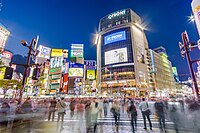
Photo from wikipedia
Artificial light at night (ALAN) is an important driver of change in ecological environments of the 21th century. We investigated the impact on nocturnal insect abundance and bat activity of… Click to show full abstract
Artificial light at night (ALAN) is an important driver of change in ecological environments of the 21th century. We investigated the impact on nocturnal insect abundance and bat activity of two LED light colors (warm-white 2700 K, cold-white 6500 K) in a peri-urban environment. Bat activity (predominantly Pipistrellus pipistrellus ) was largely driven by prey availability (insects), while insect abundance was responsive to nightly weather conditions (precipitation, temperature). Thus, both insects and bats were not differentially responsive to cold-white or warm-white LEDs. These findings are largely in contrast with literature, particularly for insects. However, as most published experiments on ALAN were conducted in areas that were lit solely for the purpose of the experiment, we would like to bring forward that (1) adaptation to environmental constraints may play a role in peri-urban environments that have been exposed to ALAN for many decades; or (2) impacts of cold-white LEDs on nocturnal insects may be lower than expected, because nocturnal insects adapted to low-light conditions may be put off by cold white light sources (6500 K).
Journal Title: Journal of Insect Conservation
Year Published: 2020
Link to full text (if available)
Share on Social Media: Sign Up to like & get
recommendations!